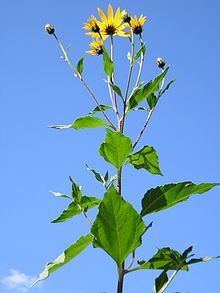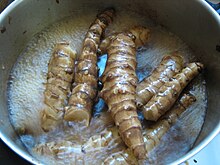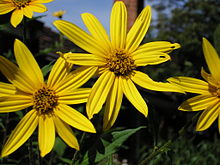Jerusalem artichoke
| Jerusalem artichoke | |
|---|---|

| |
| Stem with flowers | |

| |
| Jerusalem artichokes cooking | |
| Scientific classification | |
| Kingdom: | Plantae |
| Clade: | Tracheophytes |
| Clade: | Angiosperms |
| Clade: | Eudicots |
| Clade: | Asterids |
| Order: | Asterales |
| Family: | Asteraceae |
| Genus: | Helianthus |
| Species: | H. tuberosus
|
| Binomial name | |
| Helianthus tuberosus | |
| Synonyms[1] | |
| |
The Jerusalem artichoke (Helianthus tuberosus), also called sunroot, sunchoke, wild sunflower,[2] topinambur,[2] or earth apple, is a species of sunflower native to central North America.[3][4] It is cultivated widely across the temperate zone for its tuber, which is used as a root vegetable.[5]
Description
Helianthus tuberosus is a
The
The
Food use

The tubers can be eaten raw, cooked, or pickled.[9]
Before the arrival of Europeans, indigenous peoples cultivated H. tuberosus as a food source. The tubers persist for years after being planted, so the species expanded its range from central North America to the eastern and western regions.[citation needed] Early European colonists learned of this and sent tubers back to Europe, where they became a popular crop and naturalized there. It later gradually fell into obscurity in North America, but attempts to market it commercially were successful in the late 1900s and early 2000s.[7][10]
The tuber contains about 2% protein, no oil, and little starch. It is rich in the carbohydrate inulin (8 to 13%[11]), which is a polymer of the monosaccharide fructose. Tubers stored for any length of time convert their inulin into its component, fructose. Jerusalem artichokes have an underlying sweet taste because of the fructose, which is about one and a half times as sweet as sucrose.[10]

It has also been reported as a
Etymology

Despite one of its names, the Jerusalem artichoke has no relationship to
The artichoke part of the Jerusalem artichoke's name comes from the taste of its edible tuber. Samuel de Champlain, the French explorer, sent the first samples of the plant to France, noting its taste was similar to that of an artichoke.[19][20]
The name topinambur, in one account, dates from 1615, when a member of the Brazilian coastal tribe called the Tupinambá visited the Vatican at the same time that a sample of the tuber from Canada was on display there, presented as a critical food source that helped French Canadian settlers survive the winter. The New World connection resulted in the name topinambur being applied to the tuber, the word now used in French, German, Italian, Polish, Romanian, Russian, and Spanish.[21][22]
Cultural significance
According to Iroquois mythology, the first sunchokes grew out of Earth Woman's feet after she died giving birth to her twin sons, Sapling and Flint.[23]
History

Jerusalem artichokes were first cultivated by the
The French explorer
The French explorer and Acadia's first historian Marc Lescarbot described Jerusalem artichokes as being "as big as turnips or truffles," suitable for eating and taste "like chards, but more pleasant." In 1629, the English herbalist and botanist John Parkinson wrote that the widely grown Jerusalem artichoke had become very common and cheap in London, so much so "that even the most vulgar begin to despise them." In contrast, when they had first arrived in England, the tubers had been "dainties for the Queen."[25]
They have also been called the "Canadian truffle".[27]
Invasive potential
Biological characteristics
Its rapid growth and its ability to reproduce from buried rhizomes and tubers facilitates the Jerusalem artichoke's uncontrolled spread.[28] The vegetative propagules can be transported via rivers and water streams and begin a new population on riverbanks.[29] Dispersal by animal is also possible, as animals feed on tubers and rhizomes and excrete the propagules in new areas.[30] With humans' cultivation, there is also a risk of the plant's unintended escape into the wild.[31] It can also be propagated by seed. Its relatively long flower period enables the Jerusalem artichoke to increase its reproductive potential.[32]
Origins and distribution
Originating in North America,[33] the Jerusalem artichoke can now be found in several countries in North and South America, Europe, Asia, and Australia.[34] In Central Europe it is one of the most expanding invasive plant species.[35] It can grow in many geo-climatic regions and different types of soils.[36] However, Jerusalem artichoke prefers moist habitats[36] and seems to be less tolerant of dry conditions.[37]
Suppression of native plant species
Because of its ecological and biological attributes, the Jerusalem artichoke is highly competitive with other plant species.[38] For instance, the carbohydrates in the tubers serve as an energy source for rapid growth in spring .[36] The plant expands rapidly and creates shading, which has a suppressing effect on neighbouring plants.[39] Therefore, the risk of outcompeting and repressing the growth of native plants is increased.
Cultivation and use


Unlike most tubers, but in common with many other members of the Asteraceae (including the artichoke), Jerusalem artichoke tubers store their carbohydrate as inulin (not to be confused with insulin) rather than as starch. This has made them an important source of inulin used as a dietary fiber in food manufacturing.[40]
Jerusalem artichoke can propagate with
Crop yields are high, typically 16–20 tonnes per hectare (7–9 short ton/acre) for tubers, and 18–28 tonnes per hectare (8–12 short ton/acre) green weight for foliage. Tubers remaining in the ground lie dormant over winter and can handle temperatures as low as −30 °C (−22 °F).[51] Jerusalem artichoke also has potential for production of ethanol fuel, using inulin-adapted strains of yeast for fermentation.[5]
The tubers are used for cooking and baking in the same ways as potatoes,[52] but unlike the potato, they can also be eaten raw.[51] They have a similar consistency and, in their raw form, have a similar texture but a sweeter, nuttier flavor. When raw and sliced thinly, they are fit for a salad. Their inulin form of carbohydrates give the tubers a tendency to become soft and mushy if boiled, but they retain their texture better when steamed. The inulin cannot be broken down by the human digestive system[53] but bacteria metabolize it in the colon. This can cause flatulence and, in some cases, gastric pain. John Gerard's Herbal, printed in 1621, quotes the English botanist John Goodyer on Jerusalem artichokes:[54]
which way soever they be dressed and eaten, they stir and cause a filthy loathsome stinking wind within the body, thereby causing the belly to be pained and tormented, and are a meat more fit for swine than men.
Jerusalem artichokes have 650 mg
Use as forage
In former times, Jerusalem artichoke was used as forage for domesticated cattle, horses, and pigs.[56] The plant has valuable nutrient contents and various bioactive compounds,[57] and so is used today as an animal feed source or for the health of several animal species.[58] Pigs, for example, can eat the tuber either dried or directly from the ground or the green plant biomass (stalks and leaves) from the pasture.[59] Washed Jerusalem artichoke tubers can be fed to many animals, and silage produced from the harvested stalks and leaves.[60] The silage has high nutrient values and satisfactory digestion performance for ruminants. Its high inulin content beneficially affects the rumen metabolism and microflora.[57][61] However, cutting the tops to produce silage greatly reduces the harvest of the tubers. There are also many other Jerusalem artichoke products on the market, such as supplementary feed for horses, dogs, and small animals.[62]
| Nutritional value per 100 g (3.5 oz) | |
|---|---|
| Energy | 304 kJ (73 kcal) |
17.44 g | |
| Sugars | 9.6 g |
| Dietary fiber | 1.6 g |
0.01 g | |
2 g | |
Niacin (B3) | 8% 1.3 mg |
| Pantothenic acid (B5) | 8% 0.397 mg |
| Vitamin B6 | 5% 0.077 mg |
| Folate (B9) | 3% 13 μg |
| Vitamin C | 4% 4 mg |
| Minerals | Quantity %DV† |
| Calcium | 1% 14 mg |
| Iron | 19% 3.4 mg |
| Magnesium | 4% 17 mg |
| Phosphorus | 6% 78 mg |
| Potassium | 14% 429 mg |
| †Percentages estimated using US recommendations for adults,[63] except for potassium, which is estimated based on expert recommendation from the National Academies.[64] | |
Fermented products
In Baden-Württemberg, Germany, over 90% of the Jerusalem artichoke crop is used to produce a spirit called Topinambur, the German word for Jerusalem artichoke.[65] By the end of the 19th century, the tubers were being used in Baden to make a spirit called "Topinambur-Branntwein" (Jerusalem artichoke brandy), "Topinambur" (Jerusalem artichoke), "Topi","Erdäpfler","Rossler", or "Borbel". Topinambur produced in the European Union and Switzerland must be made exclusively from Jerusalem artichokes, contain at least 38% alcohol by volume, and contain neither added alcohol nor flavorings.[66][67] Caramel color is the only permitted additive.[66][67]
Jerusalem artichoke brandy smells fruity and has a slight nutty-sweet flavor. An intense, pleasant, earthy note characterizes it. The tubers are washed and dried in an oven before being fermented and distilled. It can be further refined to make "Red Rossler" by adding the roots of the
US marketing scheme
In the 1980s, the Jerusalem artichoke also gained some notoriety when its seeds were planted by
Diseases and pests
Stem rot disease is caused by the fungus Agroathelia rolfsii (aka Sclerotium rolfsii or Athelia rolfsii), which is one of the most important pathogens causing tuber and stem rot and up to 60% loss in Jerusalem artichoke yield.[70] Growing resistant varieties is an important method of controlling Agroathelia rolfsii.[71][72]
| Diseases of Jerusalem artichoke |
|---|
| Stem rot (Agroathelia rolfsii) |
| White mold (Sclerotinia sclerotiorum) |
| Sclerotinia blight (Sclerotinia minor) |
| Powdery mildew (Erysiphe cichoracearum) |
| Rust (Puccinia helianthi) |
| Alternaria blight (Alternaria helianthi) |
| Pseudomonas syringe pv. tagetis |
| Pests of Jerusalem artichoke |
| Tobacco cutworm (Spodoptera litura) |
| Banded sunflower moth ( Cochylis hospes )
|
References
- ^ The Plant List, Helianthus tuberosus L.
- ^ PMID 30922024.
- ^ "Helianthus tuberosus". County-level distribution map from the North American Plant Atlas (NAPA). Biota of North America Program (BONAP). 2014. Retrieved 26 April 2019.
- ^ "Helianthus tuberosus". Germplasm Resources Information Network. Agricultural Research Service, United States Department of Agriculture. Retrieved 11 December 2017.
- ^ a b c Purdue University Center for New Crops & Plants Products: Helianthus tuberosus
- ^ Dickinson, T.; Metsger, D.; Bull, J.; & Dickinson, R. (2004) ROM Field Guide to Wildflowers of Ontario. Toronto:Royal Ontario Museum, p. 170.
- ^ a b c Gibbons, Euell. 1962. Stalking the wild asparagus. David McKay, New York
- OCLC 29360744.
- OCLC 799792.
- ^ a b c d e f g Levetin, Estelle and Karen McMahon. Plants and Society: 231. Print. 2012.
- .
- S2CID 67839700.
- ISSN 0362-4331. Retrieved 9 September 2021.
- ^ Nemia-Cohen, Adi; Assis, Edna (24 May 2021). "Jerusalem Artichoke - Metamorphosis of a Mistake". Tower of David - Museum on the History of Jerusalem. Archived from the original on 9 September 2021. Retrieved 9 September 2021.
- OCLC 560560606.
- ^ Smith, James Edward (1807). . p. 108f.
A change, one presumes, of the Italian name Girasole Articiocco, sun-flower artichoke, as the plant was first brought from Peru to Italy, and thence propagated throughout Europe.
- ^ Wedgwood, Hensleigh (1855). "On False Etymologies". Transactions of the Philological Society (6): 67.
- ^ "Definition of JERUSALEM ARTICHOKE". www.merriam-webster.com. 29 March 2024. Retrieved 31 March 2024.
- ^ Marcelle Bienvenu, "Topinambour, or Jerusalem, or ground artichokes are a terrific pick: Cooking Creole" | NOLA.com.
- ISBN 9781420044966), p. 7.
- ^ Handbuch des speziellen Gemüsebaus, page?
- ^ Graham, Peter. "Chez Gram". Retrieved 17 February 2018.
- ^ Us, Kimberly (14 November 2021). "Thanksgiving: Native American Stories, Recipes and Crafts". KimberlyUs.com.
- ^ Bock, Dan G.; Kane, Nolan C.; Ebert, Daniel P.; Rieseberg, Loren H. (18 November 2013). "Genome skimming reveals the origin of the Jerusalem Artichoke tuber crop species: neither from Jerusalem nor an artichoke". New Phytologist. 201 (3): 1021–1030. Retrieved 21 August 2023.
- ^ a b c Cooke, Nathalie. Dickenson, Victoria. What's to eat? Entrees in Canadian food history. Montreal: McGill-Queen's U Press, 2010. 21-54. Print.
- ISBN 0-394-50432-1.
- ^ Méreuze, Didier (11 July 2015). "Topinambour, ouvre-toi !". La Croix (in French). Retrieved 14 January 2016.
- ^ Swanton, C.J. and Cavers, P.B. (1989). Biomass and nutrient allocation patterns in Jerusalem artichoke (Helianthus tuberosus). Canadian Journal of Botany 67: 2880–2887. DOI:10.1139/b89-369.
- ^ Balogh, L. (2008). Sunflower species (Helianthus spp.). In: The Most Important Invasive Species in Hungary (eds. Z. Botta, Dukát and L. Balogh), 227–255. Vácrátót, Hungary: Hungarian Academy of Sciencies, Institute of Ecology and Botany.
- ^ Mori, E.; Mazza, G.; Galimberti, A.; Angiolini, C.; Bonari, G. The porcupine as “Little Thumbling”: The role of Hystrix cristata in the spread of Helianthus tuberosus. Biologia 2017, 72, 1211–1216.
- ^ Filep, R.; Balogh, L.; Balázs, V.L.; Farkas, Á.; Pal, R.W.; Czigle, S.; Czégényi, D.; Papp, N. Helianthus tuberosus L. agg. in the Carpathian Basin: A blessing or a curse? Genet. Resour. Crop Evol. 2018, 65, 865–879.
- ^ Baker, H. (1974). The evolution of weeds. Annual Review of Ecology and Systematics 5: 1–24.
- ^ Wyse, D.L., Young, F.L., and Jones, R.J. (1986). Influence of Jerusalem artichoke (Helianthus tuberosus) density and duration of interference on soybean (Glycine max) growth and yield. Weed Science 34: 243–247.
- S2CID 253650690.
- ^ Fehér, A., and Končeková, L. (2009). Evaluation of mechanical regulation of invasive Helianthus tuberosus populations in agricultural landscape. Journal of Central European Agriculture 10: 245–250.
- ^ ISSN 0008-4220.
- ^ Clevenger, S. and Heiser, C.B. (1963). Helianthus laetiflorus and Helianthus rigidus – hybrids or species? Rhodora 65: 121–133.
- ^ Kays, S.J. and Nottingham, S.F. (2007). Biology and Chemistry of Jerusalem Artichoke: Helianthus tuberosus L, 1–496. Boca Raton: CRC Press.
- ^ Hoffmann, E.L. and Kazinczi, G. (2014). Chemical and mechanical methods for suppression of Jerusalem artichoke (Helianthus tuberosus L.). Herbologia 14: 63–70.
- S2CID 24828352.
- ISSN 2171-9292.
- S2CID 254505460.
- ISSN 2073-4395.
- ISSN 1161-0301.
- S2CID 242167688.
- S2CID 54978926.
- S2CID 234118654.
- S2CID 83480435.
- .
- ISSN 2073-4395.
- ^ a b Have you heard about Jerusalem artichokes? https://hungry-pumpkin.com/post/have-you-heard-about-jerusalem-artichokes/
- ^ Reynolds, Francis J., ed. (1921). . Collier's New Encyclopedia. New York: P. F. Collier & Son Company.
- colon where various bacteriadigest them - and in the process produce copious amounts of carbon dioxide gas
- ISBN 0-19-211579-0.
- ^ USDA Agricultural Research Service, http://www.nal.usda.gov/fnic/foodcomp/Data//SR20/reports/sr20fg11.pdf Archived 2012-02-06 at the Wayback Machine
- ^ Vilmorin, H.L. (1904). "Les Plantes Potagères; Description et culture des Proncipaux Légumes des climats tempéré. Troisième Èdition".
- ^ PMID 33364459.
- PMID 22558928.
- PMID 28231226.
- .
- ISSN 1300-0861.
- ^ Stolzenburg, K. (2005). "Qualität und Markt bei Topinambur – 3. Topinambur-Fachtag an der LAP Forchheim". Gemüse. 7: 31–32.
- ^ United States Food and Drug Administration (2024). "Daily Value on the Nutrition and Supplement Facts Labels". Retrieved 28 March 2024.
- )
- ^ C.A.R.M.E.N. e.V.: Topinambur - Energiepflanze für Biogasanlagen. In: Newsletter "nawaros" 11/2007, Straubing.
- ^ a b Regulation (EU) No 110/2008 of 15 January 2008 on the definition, description, presentation, labelling and the protection of geographical indications of spirit drinks and repealing Council Regulation (EEC) No 1576/89, §14 Topinambur or Jerusalem artichoke spirit
- ^ a b "Verordnung des EDI über alkoholische Getränke, Anhang 8: Mindestalkoholgehalt von Spirituosen" [Ordinance of the Federal Department of Home Affairs regarding alcoholic beverages, appendix 8: Minimum Alcohol Content of Spirits]. The Federal Government of the Swiss Confederation (in German). 29 November 2013. Retrieved 14 November 2021.
- ^ "Jerusalem Artichoke Archived 2009-11-28 at the Wayback Machine", Commercial Vegetable Production Guides, Oregon State University The effort to save the family farm, however, was not a part of our nation's goal to control the farm market, so falsifications and inaccurate understandings forced the closure of this effort. In a phone call from then Sec. of Agriculture, John Block, it was stated, "We don't want to save the family farm, but need to eliminate a certain percentage of them." Later, a book was published,
- ISBN 978-0-8166-2345-7
- ISSN 0191-2917.
- S2CID 254465204.
- S2CID 254462502.
- ISSN 2073-4395.
External links
- Helianthus tuberosus – Plants for a Future database
- Jerusalem artichoke – Ohio Perennial & Biennial Weed Guide
- NutritionData, Complete nutritional info.
- Purdue University Alternative Field Crops Manual: Jerusalem Artichoke

